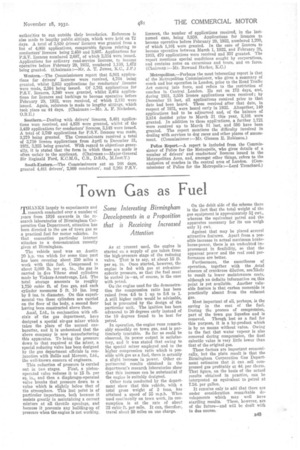Town Gas as Fuel
Page 69

If you've noticed an error in this article please click here to report it so we can fix it.
Some Interesting Birmingham Developments in a Proposition that is Receiving Increased Attention
THANKS largely to experiments and research conducted over a number of years from 1916 onwards in the research laboratories of Birmingham Corporation Gas Department, attention has been directed to the use of town gas as a practical fuel for motor vehicles. In that connection particular interest attaches to a demonstration recently given at Birmingham.
The vehicle used was an Austin 20 h.p. van which for some time past has been covering about 250 miles a week with this fuel. Compressed to about 3,000 lb. per sq. in., the gas is carried in five Vibrac steel cylinders made by Vickers-Armstrongs, Ltd. The total storage amounts to roughly 1,750 cubic ft. of free gas, and each cylinder measures 5 ft. 10 ins, long by 8 ins, in diameter. On this experimental van these cylinders are carried on the floor of the body, a second floor having been constructed above them.
Amal, Ltd., in conjunction with officials of the gas department, have designed a special air-gas mixer which takes the place of the normal carburetter, and it Is understood that the above company is now manufacturing this apparatus. To bring the pressure down to that required at the mixer, a special reducing valve has been designed by the gas department officials in conjunction with Belie and Morcom, Ltd., the well-known concern of engineers.
This reduction of pressure is carried
out in two stages. First, a pistonoperated valve reduces it to 15 lb. per sq. in., and then a diaphragm-operated valve breaks that pressure down to a value which is slightly below that of the atmosphere. This last point is of particular importance, both because it assists greatly in maintaining a correct mixture at all throttle openings, and because it prevents any building-up of pressure when the engine is not working.
As at present used, the engine is started on a supply of gas taken from the high-pressure stage of the reducing valve. That is to say, at about 15 lb. per sq. in. Once started, however, the engine is fed with gas at sub-atmospheric pressure, so that the fuel must be sucked in-as, of course, is the case with petrol.
On the engine used for the demonstration the compression ratio has been raised from 4.6 to 1 up to 5.6 to 1. A still higher ratio would be advisable, but is prevented by the design of the particular unit. The ignition has been advanced to 30 degrees early instead of the 10 degrees found to be best for petrol.
In operation, the engine runs remarkably smoothly on town gas, and is particularly tractable. So for as could be observed, its power output is satisfactory, and it was stated that owing to the special mixer employed and to the higher compression ratio which is possible with gas as a fuel, there is actually a slight increase in power. Other experimental results obtained in the department's research laboratories show that this increase can be substantial if the engine is suitably designed.
Other tests conducted by the department show that this vehicle, with a total gross weight of 3 tons, has attained a speed of 55 m.p.h. When used contia tinily on town work, its consumption is at the rate of about 22 cubic ft. per mile. It can, therefore, travel about 80 miles on one charge. On the debit side of the scheme there is the fact that the total weight of the gas equipment is approximately 51 cwt., whereas the equivalent petrol and the apparatus necessary for its use weigh only 11 cwt.
Against that may be placed several attractive features. Apart from a possible increase in actual maximum brakehorse-power, there is an undoubted improvement in flexibility, so that the apparent power and the real road performance are better.
Furthermore, the smoothness of operation, together with the ;total absence of crankcase dilution, arelikely to result in lower maintenance costs, although no definite information on this point is yet available. Another valuable feature is that carbon monoxide is practically absent from the exhaust gas.
Most important of all, perhaps, is the saving in the cost of the fuel. During the process of compreasion, part of the town gas liquefies and is removed. Though lost as a fuel for this purpose, it is a by-product which is by no means without value. Owing to the fact that water vapour is also removed during compression, the final calorific value is very little lower than that of the original gas.
These factors are important economically, but the plain result is that the Birmingham Corporation Gas Department estimates that it can sell compressed gas profitably at 4d. per therm. That figure, on the basis of the actual results obtained in practice, can be interpreted as equivalent to petrol at 7.2d. per gallop.
It remains only to add that there are under consideration remarkable developments which may well have startling results. These' however, are of the future-and will be dealt with in due course.




















































































































